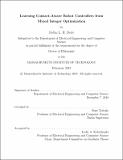| dc.contributor.advisor | Russ Tedrake. | en_US |
| dc.contributor.author | Deits, Robin L. H.(Robin Lloyd Henderson) | en_US |
| dc.contributor.other | Massachusetts Institute of Technology. Department of Electrical Engineering and Computer Science. | en_US |
| dc.date.accessioned | 2019-07-15T20:30:59Z | |
| dc.date.available | 2019-07-15T20:30:59Z | |
| dc.date.copyright | 2019 | en_US |
| dc.date.issued | 2019 | en_US |
| dc.identifier.uri | https://hdl.handle.net/1721.1/121650 | |
| dc.description | This electronic version was submitted by the student author. The certified thesis is available in the Institute Archives and Special Collections. | en_US |
| dc.description | Thesis: Ph. D., Massachusetts Institute of Technology, Department of Electrical Engineering and Computer Science, 2019 | en_US |
| dc.description | Cataloged from student-submitted PDF version of thesis. | en_US |
| dc.description | Includes bibliographical references (pages 117-128). | en_US |
| dc.description.abstract | The problem of handling contact is central to the task of controlling a walking robot. Robots can only move through the world by exerting forces on their environment, and choosing where, when, and how to touch the world is the fundamental challenge of locomotion. Because the space of possible contacts is a high-dimensional mix of discrete and continuous decisions, it has historically been difficult or impossible to make complex contact decisions online at control rates. This work first presents an approach to contact planning which is able to make some guarantees of global optimality through mixed-integer programming. That method is applied successfully to a humanoid robot in laboratory conditions, but proves difficult to rely on when the robot is experiences unmodeled disturbances. To overcome those limitations, this thesis also introduces LVIS (Learning from Value Interval Sampling) a new approach to the control of walking robots which allows complex contact decisions to be made online using a cost function trained from offline trajectory optimizations. The LVIS algorithm is demonstrated on a simple cart-pole system with walls as well as a simplified bipedal robot model, and its success at allowing both models to use contact decisions to recover from external disturbances is demonstrated in simulation. | en_US |
| dc.description.statementofresponsibility | by Robin L. H. Deits. | en_US |
| dc.format.extent | 128 pages | en_US |
| dc.language.iso | eng | en_US |
| dc.publisher | Massachusetts Institute of Technology | en_US |
| dc.rights | MIT theses are protected by copyright. They may be viewed, downloaded, or printed from this source but further reproduction or distribution in any format is prohibited without written permission. | en_US |
| dc.rights.uri | http://dspace.mit.edu/handle/1721.1/7582 | en_US |
| dc.subject | Electrical Engineering and Computer Science. | en_US |
| dc.title | Learning contact-aware robot controllers from mixed integer optimization | en_US |
| dc.type | Thesis | en_US |
| dc.description.degree | Ph. D. | en_US |
| dc.contributor.department | Massachusetts Institute of Technology. Department of Electrical Engineering and Computer Science | en_US |
| dc.identifier.oclc | 1102048289 | en_US |
| dc.description.collection | Ph.D. Massachusetts Institute of Technology, Department of Electrical Engineering and Computer Science | en_US |
| dspace.imported | 2019-07-15T20:30:55Z | en_US |
| mit.thesis.degree | Doctoral | en_US |
| mit.thesis.department | EECS | en_US |
